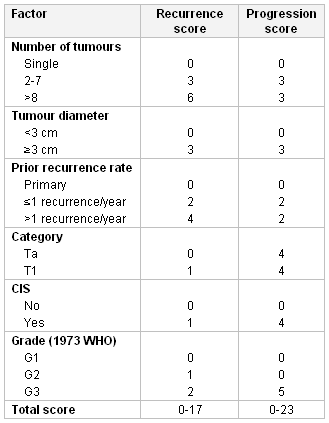Criteria
Biopsy determination of grade and stage
Stage
The tumour-nodes-metastases staging system is most widely used.[3][4] Non-muscle-invasive bladder cancer (NMIBC) includes carcinoma in situ (CIS) and papillary or solid tumours confined to the urothelium (Ta) and invading the lamina propria (T1). Approximately 75% to 80% of bladder tumours present as non-muscle-invasive disease and the remainder present as muscle-invasive disease.[2] In non-muscle-invasive disease, approximately 70% present as Ta lesions, 20% as T1 lesions, and 10% present as CIS or Tis lesions.[2]
The previous terminology that referred to muscle-invasive tumours (T2) as invasive and NMIBC as superficial is incorrect and should be avoided. T2 tumours invade muscularis propria. Tumours extending into perivesical fat are T3 and those into adjacent organs are T4. Nodal metastasis (N) and extrapelvic metastasis (M) complete the system.
Grade
The 1973 World Health Organization graded urothelial carcinoma as well differentiated (grade 1), moderately differentiated (grade 2), and poorly differentiated (grade 3).[6] In 2004, WHO along with the International Society of Urological Pathology changed the grading system and created 3 grades: i) papillary urothelial neoplasia of low malignant potential, ii) low-grade urothelial carcinoma, and iii) high-grade urothelial carcinoma.[5][7] The European Association of Urology guidelines suggest using both the 1973 and 2004/2022 systems concurrently, or a hybrid system.[48] High-grade tumours (including all grade 3 and CIS and some grade 2 WHO 1973) are aggressive tumours that if not controlled by intravesical therapy are a threat to life.
European Organisation for Research and Treatment of Cancer (EORTC) scoring system
Heterogeneity in bladder tumours complicates the ability to compare the efficacy of different treatment modalities and thereby establish unified treatment recommendations. Therefore, risk stratification is imperative for classifying patients with similar risks of recurrence and progression and helps to determine the appropriate management strategies for each risk category.
Although limited by older chemotherapy treatments and the relatively few bacille Calmette-Guérin (BCG) trials included, which may overly increase the estimated risk, the EORTC risk tables are considered useful for estimating progression and/or recurrence of NMIBC. The EORTC scoring system combines data on previous tumour recurrence rate, number of tumours, tumour diameter, T category, and WHO grade, and the presence or absence of concomitant carcinoma in situ, to estimate risk of recurrence and progression.[79]
[Figure caption and citation for the preceding image starts]: European Organisation for Research and Treatment of Cancer (EORTC) scoring system: weighting used to calculate recurrence and progression scores. CIS, carcinoma in situFrom World J Urol. 2007 Jun;25(3):285-95; used with permission [Citation ends].
[Figure caption and citation for the preceding image starts]: European Organisation for Research and Treatment of Cancer (EORTC) risk tables: probability of recurrence and progression according to scoreFrom World J Urol. 2007 Jun;25(3):285-95; used with permission [Citation ends].
The main limitation of the EORTC risk tables is that the risk groups were based on patients who, for the most part, were treated with older intravesical chemotherapy regimens. BCG was infrequently used. With increased use of BCG, data show that the tables over-estimate risk of recurrence and progression.[80]
The Web-based EORTC risk calculator based on these tables can be downloaded and used to determine the most appropriate treatment strategies based on risk of progression and/or recurrence. European Organisation for Research and Treatment of Cancer (EORTC) scoring system and risk tables for stage Ta T1 bladder cancer Opens in new window
Use of this content is subject to our disclaimer